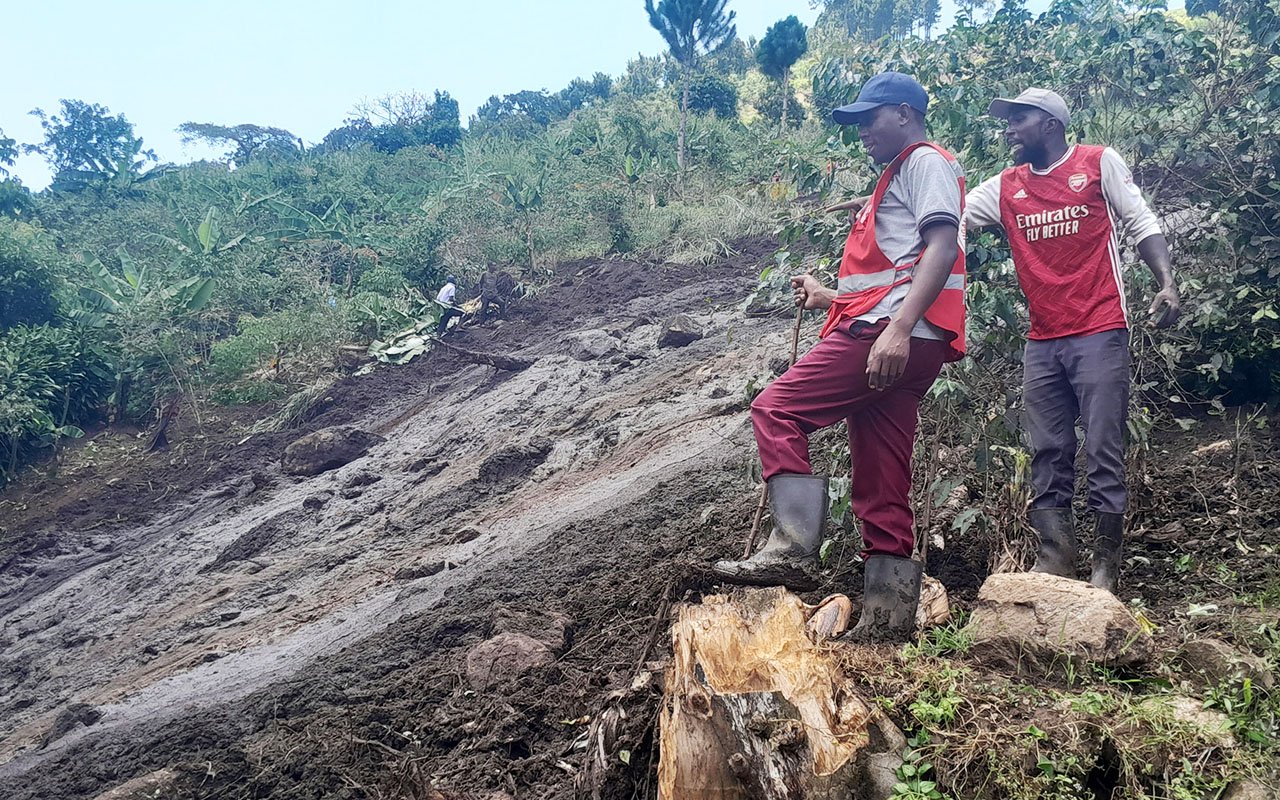Residents live in fear over mudslides scare

A Red Cross official and residents inspect an area affected by mudslides in Nyakabugha Village, Kasese District in April 2024. PHOTO/JEROME KULE BITSWANDE
What you need to know:
- The water to run the turbines is drawn from River Mubuku at Nyakalengijyo Trading Centre, passing through a flume line via Nyakabugha, Kiharara, and eventually down the hill at basecamp in Ibanda.
A looming disaster of mudslides is threatening residents of Ibanda-Kyanya Town Council in Kasese District after several reported incidents of flume pipes leakages.
The leakage is part of Mubuku I Hydro Power Station, which has weakened the soil and caused small cracks.
A flume pipe is used to carry or transport water under a driveway, road, or other obstacles.
Residents from the villages of Nyakabugha and Nyakalengijyo say they are living in fear and have requested the power station to shut operations until the leakages are stopped.
The maintenance of the flume line, which runs on the ground, according to locals has been neglected by the government since the Canadians evacuated Kilembe Mines Limited, resulting in leaks that allow water to enter the ground and weaken the soil.
Mr Ivan Mawano, a resident of Nyakabugha Cell in Ibanda-Kyanya Town Council, said the water leakage began many years ago and they have never seen any repairs. He added that all the pieces of land in the area are prone to mudslides.
“Together with my family, we decided to migrate from our initial house because we were scared that it would one day collapse, I have been renting a house at our nearby trading centre for the last two months for safety,’’ he said.
On March 17, a mudslide devastated Nyakabugha Village, destroying acres of crops including cassava, bananas, beans, and coffee, and residents attributed the disaster to the continuous leakage from the flume lines. The incident occurred just a few metres away from Mawano’s house.
“Water has submerged my house and rendered it uninhabitable, I believe the managers of this flume line don’t prioritise the lives of people living below it. They seem more concerned about their profits than the safety of the community,” he said.
While Mawano’s house remains standing, for Ms Mary Masika, aged 52, her semi-permanent house was destroyed in the March 17 mudslides, leaving her and her five children homeless.
“I was inside the house with my children when I heard a loud bang outside, I rushed out and saw a mudslide flowing from above. I grabbed the two children who were inside the house and fled. Within moments, the entire house was buried. It is heartbreaking that there’s now no trace of the house,’’ he said.
She adds: “Everything was washed away – my house and all its contents, including the bed, mattresses, bedding, clothes, livestock, coffee, and even the Shs300,000 I had borrowed from a local Sacco.’’
Ms Peace Tusiime, aged 60, who has resided in the area for the past 30 years, recalls a time when the area was dry and they would travel several kilometres to River Mubuku to fetch water.
“When I arrived here in 1992, we had to trek to River Mubuku to access water. But nowadays, water seems to be seeping out of the land from every direction. There is excess of water in our land due to the continuous leakages from this flume line, government must act swiftly to come to our rescue,” she said.
Ms Tusiime now urges the government or Kilembe Mines Limited to compensate them so that they relocate to safer areas.
Mr Benard Tabaro, a senior manager at Kilembe Mines Limited, said the flume line is outdated and requires expensive maintenance. However, he argues that advocating for the closure of the powerhouse and shutdown of the operations of Kilembe Mines Limited is harsh because the power distribution company plays a crucial role in the area’s development.
“This flume line was constructed in the 1950s, long before many of us were born. I believe the priority now is to devise strategies for peaceful coexistence with the flume line. In the meantime, we have temporarily ceased running water through it as we explore solutions to repair the damages,’’ Mr Tabaro said.
Aging system
But Mr Bernard Masereka, the chairperson of the Works and Technical Services Committee of Kasese District, criticised Kilembe Mines Limited for failing to maintain the flume line despite repeated reminders.
“This is an ageing system constructed in the early 1950s to provide power for Kilembe Mines Limited. Despite efforts to conduct maintenance, Kilembe Mines has failed to uphold the flume line to the required standards, resulting in persistent leaks that weaken the soil,’’ Mr Masereka said.
Established in the 1950s, the power station currently generates five megawatts.
The water to run the turbines is drawn from River Mubuku at Nyakalengijyo Trading Centre, passing through a flume line via Nyakabugha, Kiharara, and eventually down the hill at basecamp in Ibanda.
BACKGROUND
Established in the 1950s, the Mubuku Hydro-Power Station, served as the primary source of electricity to support copper mining activities in Kilembe during the 1960s and 1970s.
During this period, the maintenance of the power trail, from the water sourcing point in Nyakalengijyo to the flume line stretching to Ibanda, was overseen by the mining company, Kilembe Mines Limited (KML).




